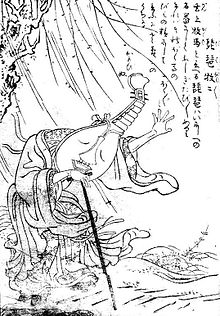Biwa-bokuboku
The Biwa-Bokuboku ( Jap. 琵琶牧々 ) is a fictitious beings from the traditional , Japanese folklore and belongs to the group of Yōkai .
description
The biwa-bokuboku is usually described as a biwa (Japanese lute ) with a human body, it is said to be often dressed in an expensive kimono . Either the Biwa-bokuboku sits in a tatami room and complains, singing and plucking, that his former owner has been neglected, or he dances noisily through the rooms. Other Biwa-bokuboku leave the house and wander around playing like street musicians for money.
background
The design model was the biwa , a traditional, short-necked lute made of wood. Toriyama Sekien reports in his work Hyakki Tsurezure Bukuro that the Biwa-bokuboku were previously the imperial , Heian-temporal sounds Bokuba ( 牧馬 ) and Genjō ( 玄 上 ).
The Biwa-bokuboku is named after one of these legendary Biwa: after the Bokuba , which traditions from the Edo period tell us about being a magical lute that plays by itself when no one is looking. Their sound is said to be so beautiful that even Oni would fall for their game.
The being Biwa-bokuboku belongs to a special group of yōkai, the tsukumogami ( 付 喪 神 , dt. "Artifact spirits"): According to Japanese folk belief, household appliances and musical instruments of all kinds can turn into yōkai after 100 years, because too they have a soul. Biwa-bokuboku also develop a life of their own when they make their “100. Birthday ”. If they have been neglected and poorly cared for up to then, they will chase the residents and frighten them at night with music that is intentionally played crookedly. Other Biwa-bokuboku seek out other tsukumogami and join forces with them. At best, Biwa-bokuboku, like other tsukumogami, leave the house and wander around street musicians.
literature
- Katsumi Tada: 幻想 世界 の 住 人 た ち. 4, 日本 編 . Shinkigensha, Tokyo 1990, ISBN 978-4-915146-44-2 , p. 303.
- Sekien Toriyama, Mamoru Takada, Atsunobu Inada and others a .: 画 図 百 鬼 夜行 , Kokusho Kankōkai, Tōkyō 1992, ISBN 9784336033864 , p. 295.
- Masaharu Takemura: ろ く ろ 首 考: 妖怪 の 生物学 . Bungei-sha, Tokyo 2002, ISBN 4835546350 , pp. 89-91.
- Yoshida Kenko: Essays in Idleness . Cosimo Inc., New York 2009 (new edition), ISBN 1605208051 , p. 32.
Web links
- Description of the Biwa-bokuboku on Yokai.com . (English)
